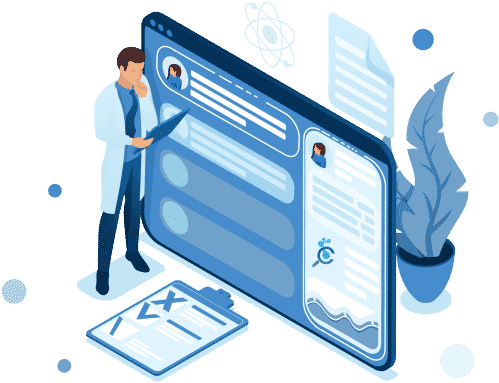In the old days, medicine began as a set of philosophies and traditions in an attempt to alleviate pain and treat diseases, and medicine differed in different cultures, then medicine moved from traditional medicine to herbal medicine.
Since then the methods of diagnosis and treatment are still developing, and ways of recording and recording data are evolving to store patient information in an effort to improve the health system, one of the most recent is the electronic patient record.

The electronic patient record is a paperless system that enhances the process of smooth data extraction so that the health data of each patient is easily available to healthcare providers away from paper data that contains handwritten notes.
The goal, then, is to obtain the patient’s data in a seamless manner and to know his medical history and the methods of treatment he receives.
This type of application helps in communicating with healthcare providers simply and more flexible access to patient records, allowing them to provide safe and accurate care with complete knowledge of the patient file and thus obtaining high-quality care,
This will be noticed through rapid communication and coordination between him and the team Healthcare in relation to his health condition and treatment.
But some of us are getting confused when they try to differentiate between the electronic medical record (EMR) system and the electronic health record (EHR)system.

What is the Electronic Medical Record (EMR)?

The electronic medical record (EMR) is an electronic system that archives all personal and medical information related to the patient, including his medical history, laboratory results and reports, radiology results and reports, and prescriptions.
In addition to recording all the medications he takes, allergies to different medications, and everything related to the patient’s health and treatment aspect. Which was recorded during the patient’s interaction with that doctor or a particular institution.
The electronic medical record (EMR) also includes all medical services provided to the patient since the establishment of the record, and it is similar to the paper file used in the hospital.
This system is applied within one hospital only, and information is not exchanged with other facilities or health centers.
The Electronic Medical Record (EMR) can be described as a patient’s computer-based information store with all its advanced capabilities of storing that information, processing and transferring data through specific networks within the environment of a single facility.
Benefits of the Electronic Medical Record (EMR)
- Storage of data and information and the speed of access to it.
- Managing laboratory and radiology results effectively.
- Electronic communication between departments.
- Better management of the patient’s condition among the medical staff supervising the case.
- Submit a report on patient health management.
- Improving the performance of the healthcare facility.
- Error rate is much lower than paper records.
Read Also
- From Student to Soldier: Preparing for a Seamless Transition into the Army Nurse Corps
- Understanding the Impact of Patient Engagement in Healthcare: Definition and Benefits
- Enhancing Healthcare Operations with Revenue Cycle Management Staffing
- Engaging Patients and Communities Through PR in Healthcare
- Healthcare Compliance with Mutagenicity Guidelines: Challenges and Strategies
What is The Electronic Health Record (EHR)?

The electronic health record (EHR) links several independent health facilities, whether inside or outside the same system.
Each of these facilities has an electronic medical record system, and thus all of them are linked into one integrated system called the Electronic Health Record -EHR system, thus making patient information available at the level of a sector or a country, which makes sharing medical records easier among many From service providers it is the main advantage of this system.
The Benefits of the Electronic Health Record (EHR)
1- The ability for the patient to view all his medical data and share it with whomever he wants.
2- The possibility of obtaining electronic services such as taking appointments and obtaining the results of laboratory tests and medical reports.
3- Raise the efficiency of work within the facility and utilize human resources more effectively.
4- The possibility for the patient to obtain preventive medicine services and better follow up on his health affairs.
5- Doctor’s productivity increases because scheduling appointments, ordering tests, and prescribing medications are all done electronically.
6- Prevent duplication of treatment or tampering with prescriptions and reduce error.
7- Lower cost to the individual and the cost of maintaining paper records.
The Value of Electronic Patient Records (EPR)

Whatever the difference between them, the application of the electronic medical record (EMR) and the electronic health record (EHR) carries with it many benefits that are positively reflected on the performance of healthcare providers on the one hand and on the health of the patient on the other hand.
Implementation of such systems in healthcare facilities reduces errors much less than paper records, and greatly improves communication between doctors, allowing each party to have full access to the patient’s medical history instead of a quick look during the patient’s visit to the clinic.
Physicians can reach an accurate diagnosis more quickly by easily viewing the patient’s test results and checking past results or any medical practices the patient has had in the past.
The use of electronic patient records allows health care providers to simultaneously access a patient’s record from any computer.
An electronic record can provide up-to-date information about a patient’s complete medical history, including results of current examinations and recommendations of other physicians, allowing for more effective collaboration across multiple aspects of patient care.
Medical practitioners can also quickly transfer patient data to departments or other providers while reducing errors and improving outcomes management.
These records ensure that the patient obtains a better diagnosis with a very low error rate, as the patient receives advice and preventive measures that contribute to improving the management of his disease.
This flexibility in accessing a patient’s complete records means that there is no need to fill out the same paperwork and data at every visit to the doctor because the results and images are all in one place. The result is better management of disease states, especially chronic conditions, better care and more accurate diagnosis.
The True Difference Between EMR & EHR

The electronic health record (EHR) is a system similar to the electronic medical record (EMR), but the difference between both is that the EMR is designed to suit individual practice.
Meaning the possibility of using the patient’s file in one hospital or clinic, and not to share with all doctors in different bodies and places.
In other words, the electronic medical record is a limited perspective on the health status and medical history of the patient.
While the electronic health record (EHR) gives a more comprehensive and general view, and remembers the patient’s data with all doctors and different authorities.

